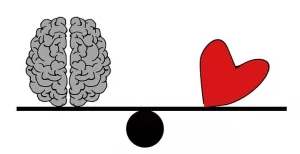
Dual process theory describes the interactions between intuitive and deliberate thinking. Understanding these two modes of reasoning provides clues to help improve our decision making.
From the workplace, to personal interactions, the ability to reason well and make good decisions can lead to better outcomes in nearly every sphere of life.
If you’ve ever wondered about what exactly is happening in the brain to inform your thought processes, you’re not alone.
By studying how people think and make decisions, we understand our own minds a bit better. And that gives us a leg up on how to improve them.
At this point, there’s a growing body of research that shows that people draw on two distinct types of thought process to reason through problems, often without being aware of it.
In their paper, “Dual process theories of higher cognition: Advancing the debate,” published in Perspectives on Psychological Science, Jonathan Evans and Keith Stanovich discuss the scientific literature surrounding the idea of dual process theory in decision making and reasoning.
So, what are these dual processes? And how does our brain decide which of them to use when it’s time to make a big decision?
As Evans and Stanovich write, the idea that we have two primary modes of thinking, “one fast and intuitive, the other slow and deliberative, is both ancient in origin and widespread in philosophical and psychological writing.”
Considerable research has been devoted to understanding these processes since the 1970s and 1980s. The Nobel prize winning psychologist, Daniel Kahneman gives a detailed account of this work in his book, Thinking, Fast and Slow.
So, what are these two processes? And how do they work together to help us through challenging decisions?
In dual process theory, the two types of cognitive processes are often called Type 1, which is more intuitive, and Type 2, which is analytical.
There are several differences between these two approaches to thinking and decision making.
One of the key distinctions is that Type 1 processing tends to be much quicker. These are what we think of as “gut” decisions that we arrive at quickly, and usually with some level of confidence. As Evans and Stanovich note, “when people are confident of an initial intuitive answer, they are less likely to spend time rethinking it or to change their answer after reflection.”
On the other hand, Type 2 processing requires what cognitive researchers sometimes call “hypothetical thinking.” Instead of making an in-the-moment decision, this approach tends to be slower, and requires more thought about how the decision may impact events in the future. This brings elements of critical thinking in to support your decision making process.
In addition, since Type 1 decisions are made from a more grounded place of instinct, they tend to require less of our working memory. For example, if a parent sees their toddler in the street, they don’t need to remember a complicated series of steps required to move the child out of harm’s way.
They just run.
By contrast, when faced with an unusual, tricky decision at work that requires consideration of several conflicting viewpoints, your brain is tasked with holding much more information in your head at one time.
It can be easy to oversimplify dual process theory and assume that Type 2 answers are generally better because they are, by definition, more carefully thought through. But Evans and Stanovich argue to the contrary, writing that:
perhaps the most persistent fallacy in the perception of dual-process theories is the idea that Type 1 processes (intuitive, heuristic) are responsible for all bad thinking and that Type 2 processes (reflective, analytic) necessarily lead to correct responses.
In the example above, a parent’s slow response to save their child from danger could have severe consequences. In some cases, those fast, gut level Type 1 decisions can help us stay safe.
But if we find that we’re only making quick, instinctual decisions all day long, this means that we’re not always keeping an eye on our own vision of the next steps we need to achieve our goals.
By staying in a state of constant “busy-ness,” we tax our working memory with the demands of job stress, family, friends, and social networks. It’s all too easy to quickly make decisions in the Type 1 zone, even when we shouldn’t.
Sometimes, the best thing we can do is slow down, take a breath, consider the future impact of the decision before us, and employ a bit of higher level, multi-step thinking to figure out the best solution to our concerns.
Both Type 1 and Type 2 processes usually come into play, even in rapid, life or death decision making. Hence, the ability to draw on a mix of intuition and analysis reflects one of our key decision making skills.
As human beings, we’re fortunate to use our complicated brains in a myriad of ways. When we understand how our brains work, we can gain clarity, improve our cognitive performance, and make better decisions every day.
Image Credit: ElisaRiva
